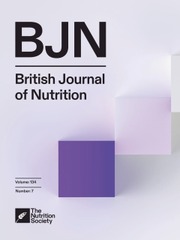No CrossRef data available.
Article contents
TNF-α –1031T/C and –863C/A polymorphisms are associated with dyslipidaemia
Published online by Cambridge University Press: 31 July 2025
Abstract
TNF-α polymorphisms may influence dyslipidaemia, but their role remains unclear. This case–control study investigated associations between TNF-α gene polymorphisms (–1031T/C, −863C/A, −857C/T, −308G/A and −238G/A) and dyslipidaemia in 595 participants (162 cases, 433 controls) from the Chaoshan region of China. Anthropometric, biochemical and genetic data were analysed using χ2 tests and logistic regression, with the false discovery rate (FDR) method applied to correct for multiple comparisons. Results revealed that only the −1031T/C and −863C/A polymorphisms were significantly associated with dyslipidaemia. Carriers of the TC + CC genotype for −1031T/C (OR = 0·48; 95 % CI: 0·30, 0·78; PFDR = 0·006) and the CA + AA genotype for −863C/A (OR = 0·41; 95 % CI: 0·24, 0·70; PFDR = 0·004) had lower odds of dyslipidaemia. Protective effects were observed for the C allele at −1031T/C (OR = 0·58, PFDR = 0·012) and the A allele at −863C/A (OR = 0·47, PFDR = 0·004). Stratified analyses showed that these associations were significant in males but not females. Functional annotation linked these TNF-α gene polymorphisms to transcription factors (e.g. HNF-1A, STAT1β) in the adipogenesis pathway. This study reveals genetic associations between TNF-α polymorphisms and dyslipidaemia, particularly in males, and provides mechanistic insights into their role in transcriptional regulation.
Information
- Type
- Research Article
- Information
- Copyright
- © The Author(s), 2025. Published by Cambridge University Press on behalf of the Nutrition Society


